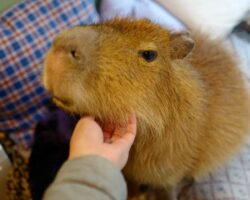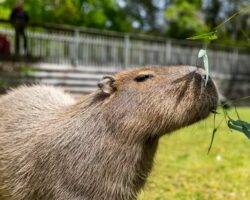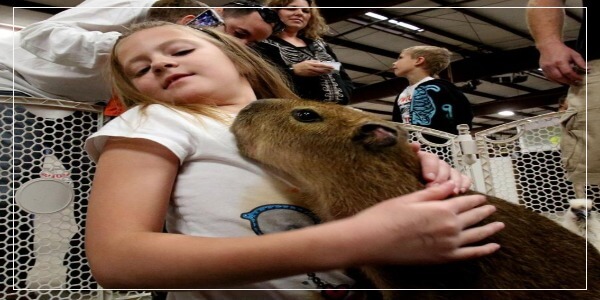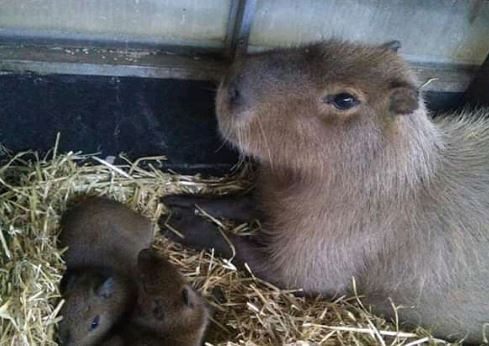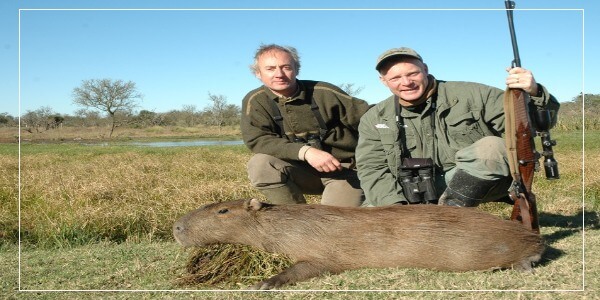Most South Americans now farm capybaras for the daily consumption of their meat. However, this is not so in other areas where you can’t hunt, hurt or farm them and you may compulsory need to be permitted by the appropriate authorities to be able to own a capybara.
Capybaras are the world’s largest rodents standing at 2 feet tall. If you could farm grass cutters and hamsters? Can capybara’s be farmed? Of course! They can be like any cow, pig, or sheep.
The name “Capybara” comes from the language of the South American Indians, roughly translated as “Lord of Herbs.” They indeed run the meadows. Unlike guinea pigs, capybaras in their natural environment spend most of their lives in water. However, they do feel good in city apartments as pets.
What States Are You Allowed To Farm Capybaras?
Keeping capybaras is not legal in every U.S state. And some counties in those states that approve might have strict restrictions. A capybara is an exotic animal. Strict laws have been laid for owning and rearing such animals to combat animal abuse and cruelty.
You can legally own a capybara in Pennsylvania, Texas, parts of New York, Arkansas, Nevada, Florida, Arizona, Washington, Indiana, and North Carolina.
You still have to get a license and permit to keep this animal. You have to be informed about the exotic laws in your area before you embark on getting a capybara.
Capybaras are illegal in California and Georgia. Why Are they banned In California? One simple reason. They are wild animals. Authorities say they can cause harm to crops and local wildlife if they are introduced domestically.
In Canada, however, each province has its laws and regulations that govern Capybaras ownership and rearing. Mind you, many pets banned in California are legal in other US states.
Are Capybaras Livestock?
Cattle are livestock, so are pigs. You can watch them graze in a flock, around gardening of figs. But can you rear capybaras? Is that world’s largest rodent fit to be livestock? The answer is yes. Capybara produces exceptional meat.
Drop that stereotypical nonsense that all rodents are stupid. The capybara may be docile, but it has a well-developed intellect and herding instinct.
In the wild, they live in small communities of around 20 individuals with a strict hierarchy. To get a great farm, you can mimic this order. The dominant male owns all the females, the rest of the animals do not have access to them.
The same instincts of possessiveness will remain at home, but you won’t see any aggression. Instead, the beast will draw more attention to itself, pushing its muzzle up its leg and calling out to play. But there would need constant care. Capybara constantly needs water but not to drink but swim.

Of course, you can suck water into the bathroom every day, but I don’t think your neighbors would appreciate it if you flood their apartment! To solve this problem, start a capybara with a country house with a clean pool or pond, where the rodent will feel at home.
The capybara house does not require any maintenance. Simple feed it, give it a place to swim and play. The animal will take care of everything on its own, his teeth, eyes, ears, fur. It is a pretty tough rodent you know.
The rodent has enough intelligence for you to train it; you can teach it simple tricks. Like responding to commands and even understanding human language!
The nature of these rodents is phlegmatic. It is a sluggish animal. He is too lazy even to build himself some sort of dwelling. They sleep on the damp earth, and only sometimes can they dig a tiny hole in it for convenience.
RECOMMENDED
Are Capybaras Land Animals?
Overland and on the sea, Capybaras are everywhere they want to be. If this animal were military, he would be in the Seals. No, they can’t fly! lol, Funny you!
But they are excellent swimmers, good free divers, equipped with webbed fingers and a powerful thrust. The capybara is adapted to a semi-aquatic life and spends much time in the water.
It can cover great distances underwater, stay several minutes without rising to the surface and splash around for many hours.
With its eyes, ears, and nostrils being placed high on the head, it can see and breathe while swimming. It can even sleep off in the water! Like a Hippopotamus, it stays in the water where it basks for a long time to calm its temperature and for maintenance of its skin.
What Are Capybaras Raised For?
Capybaras are raised for their meat and hide. But most importantly, their meat. For a long time, locals have hunted them for food.
Their meat is rich in proteins and has low cholesterol fat (lean fats). This makes that nutritional better than beef. “Capy” meat can be used as a substitute or best a complementary to stake and mutton.
Its hide produces excellent leather too. Someone call Christian Dior. There is a new leather king in town.
Does Capybara Eat Meat?
No. Unlike other rodents that are somewhat omnivore, the Capybara is an herbivore. Its diet, a mixture of green grasses, aquatic plants, stem tubers, and barks, makes it a strict vegetarian.
Add a touch of sugar cane, and this animal could give Ariana Grande a run for her money (also green) on the vegetarian ladder board. But there is a dark side to this tale. Capybaras are coprophagous! This means they can and will eat their feces. Yuck!
Wait, before you judge the poor fella, this is the reason why it does that. Capybara’s feces contain intestinal bacteria which help to digest the cellulose in the grass and other greens which they eat and extract proteins and minerals. It’s a double win, win situation after all, don’t you think?
Without being a ruminant, it regurgitates and like a rodent, its gnawing teeth are constantly growing to counter the effect of its constant use.
Capybara may have a good time being a vegan, but it also depends heavily on Mom’s milk when it is young. And when I say “mom”, I mean a different concept than you are used to. Since new youngsters are catered for in a nursery, Mom can be any lactating female in the nursery.
It’s the diet for the first four months of his life. A mixture of milk and greens. So maybe it is a lacto-vegetarian then!
Is It Lawful To Keep A Capybara?
There is nothing illegal in keeping capybaras if the laws of the area you live permitted. They are like any hamster, squirrel, and beaver. The only hitch is that you must provide adequate care for them, room to explore and follow all animal regulations that govern your area.
Capybaras bond well with humans and other pets alike. They have seen to adopt stray animals that are not of their species and take care of them. They are truly wonderful animals.
What Is The Cost Value Of A Capybara?
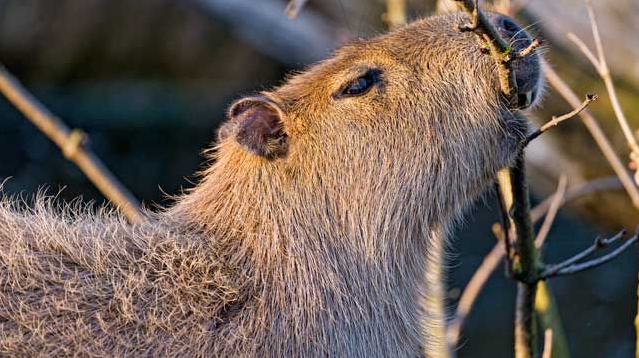
You can buy a capybara only in specialized nurseries, at the consultation of a veterinary doctor. The price of an animal can be as high as $1000 to $3000. This may be genuinely high, but these animals are worth it.
Reasonably you should buy two, a male and a female, because they don’t enjoy being alone and so that they can make more capybaras, females are costlier. And remember, you are responsible for those we have tamed!
No matter how patient you are, it’s not such a good idea to take on a wild capybara. You will not be able to domestic it, and it might get even wilder from the stress you will cause it.
Check out the health of the animal before buying. A healthy animal would have smooth skin, and damp nozzles; red or dark patches on the skin suggest ticks and mites.
What Is A Capybara Classified As?
The Capybara (Hydrochoerus hydrochaeris) is classified as a rodent. It is placed in the same family as rats, guinea pigs, squirrels, and beavers. They’ve got the big gnawing teeth too!
Resembling a large hamster, the capybara sports a heavy build and a massive body. Its small ears, black eyes, and nostrils are located on the top of a large rectangular head with a broad muzzle.
The capy has short, hard hairs whose brown color turns yellowish on the ventral part. Its short webbed legs are characterized by hind legs that are longer than the forelegs.
The feet are extended by four toes at the front and three at the back with short claws. Its high-fat mass allows it to fight against the cold in the water and to float more easily.
The capybara has no tail. The male is distinguished by a protuberance blackish on the muzzle (Morillo) which contains a gland secreting a substance intended for territorial marking.
Social Life of Capybaras
Social cohesion in the capybara is advanced. A gregarious animal, the capybara evolves within family herds of about twenty individuals, made up of a dominant male, young teenage capybaras, several females, and their cute youngsters.
In the dry season, the clan can greatly expand to gather around the rare bodies of water available.
The rodent owes its survival in large part to the good cohesion of the group in which the young benefit from the protection of all the adults and a female can suckle her offspring as well as that of the other members of the tribe.
A repertoire of cries helps communication between individuals. Cries alternate amongst whistling, growling, and even barking depending on the reasons for the alert. They are diurnal animals.
The capybara lives in South America (Brazil, Guyana, Bolivia, Argentina, Uruguay, Venezuela) where it is observed in wooded areas, savannas, dense forests, and in the Andes, always near water.
The rodent is subservient to wetlands, flooded meadows, marshes, lakeshores, slow-moving rivers, swamps, ponds, and rivers.
How Do Capybaras Reproduce?
Mating takes place all year round in water after a ground courtship display. Following the breeding of the dominant male with the females of the group, begins a gestation period of 150 Days.

At the end of which the birth occurs in a shelter of dense thickets. The litter includes three or four pups capable of feeding and following their parents within hours of birth.
Newborns are weaned after sixteen weeks and stay with their mothers for six months. The young males will then be chased away by the chieftain.
READ MORE: All You Need To Know About Capybara Reproduction
Life Span & Preys
On land, the main predators of the capybara are the jaguar, puma, and ocelot. In the water, the life of the rodent is threatened by the anaconda and the caiman.
The capybara was intensely hunted by herders who wrongly accused them of grazing the grass of their herds. Hunting (authorized in certain countries with quotas) gave way to breeding for the trade of its meat and its skin.
With a stable population in its range, the capybara is classified as “Least Concern” by the International Union for the Conservation of Nature (IUCN). There was a time when their numbers dwindled dangerously.
The lifespan of a capybara is 10 to 12 years in the wild and up to 20 years in captivity.
Health Concerns
Aside from vitamin C deficiency, they are relatively hardy creatures. Like most rodents, capybaras are prone to respiratory infections and infestations with mites or lice in their fur.
To prevent these issues, keep the pen clean. If your capybara appears listless or stops eating, it may have a digestive problem.
Amazing Fun Facts
Capybara eats only six types of plants. They are seriously picky about the type of green, herb, and bark they eat. That gives them an edge against Ariana, doesn’t it?
Their old cousins were twice as long and weighed as much as eight times. If they were not extinct, they would have been as big as a small grizzly bear.
Fossils evidence of extinct capybaras can be found in County’s Oceanside, San Diego. 16th century Catholic Church grouped the capybara, like a fish because they can swim. Thus they could be eaten on Fridays during Lent.
Conclusion
Capybaras are great animals. And if you want to farm them because of their meat or skin, or want them as a pet, they are worth an investment. Call your local vegetarian for an honest recommendation.


![Capybara Meat And Its Culinary Uses - [Every You Should Know] Capybara Meat & Culinary Uses](https://capybaratips.com/wp-content/uploads/2023/03/Capybara-meat-250x200.webp)
